-
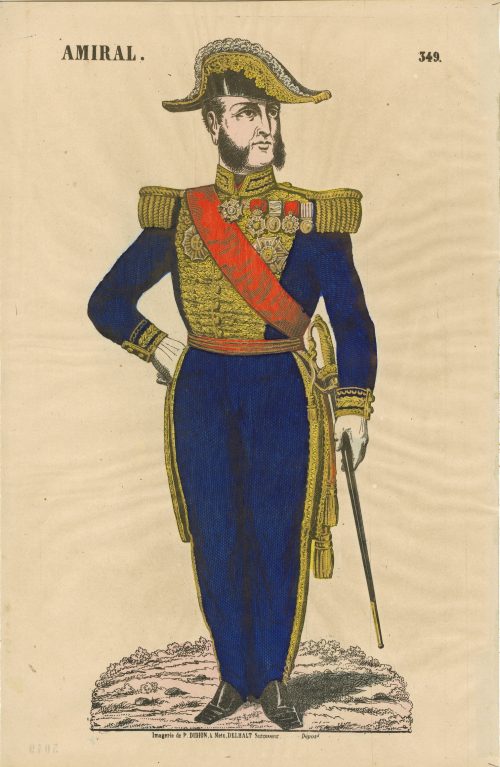 Hand-coloured woodcut on wove paper, 440 x 285 mm; black ink stamp “5049” to reverse. Top left: "AMIRAL"; right: "349". Below: "Imagerie de DIDION, à Metz, DELHALT Successeur." — "Déposé." Paulin Didion (French, 1831 – 1879) – publisher/printer.
Hand-coloured woodcut on wove paper, 440 x 285 mm; black ink stamp “5049” to reverse. Top left: "AMIRAL"; right: "349". Below: "Imagerie de DIDION, à Metz, DELHALT Successeur." — "Déposé." Paulin Didion (French, 1831 – 1879) – publisher/printer. -
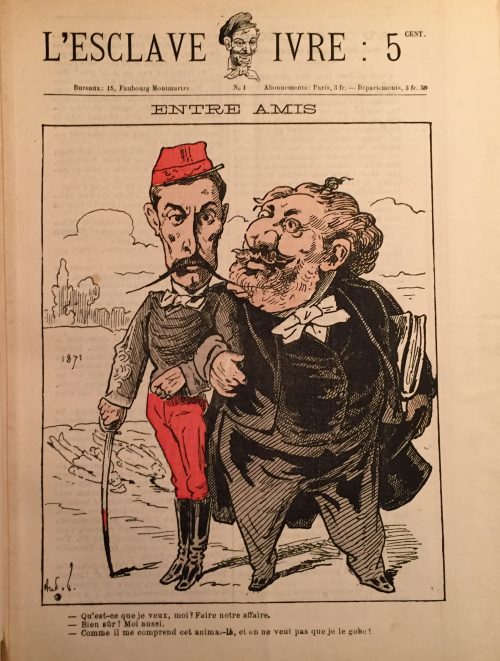 Artist: André Gill [real name Louis-André Gosset] (French, 1840 – 1885). L'Esclave Ivre [The Drunken Slave] was a Parisian weekly, published in 1881, 4 issues total. Léon Gambetta (French, 1838 – 1882) stands arm in arm with Marshal Patrice de MacMahon (French, 1808 – 1893). Dead bodies of communards lie in the midground and a landscape is faintly perceived in the background. 1871 is written on the hill on the left. L'Esclave Ivre, Issue 1. Entre Amis. Text below the image: - Qu'est-ce que je veux, moi? Faire notre affaire. / - Bien sûr! Moi aussi. / - Comme il me comprend cet animal-là, et on ne veut pas que je le gobe! [In between friends / - What do I want? To make a deal. / - Of course! Me too. / - How well this animal understands me, and we do not want me to swallow him!]
Artist: André Gill [real name Louis-André Gosset] (French, 1840 – 1885). L'Esclave Ivre [The Drunken Slave] was a Parisian weekly, published in 1881, 4 issues total. Léon Gambetta (French, 1838 – 1882) stands arm in arm with Marshal Patrice de MacMahon (French, 1808 – 1893). Dead bodies of communards lie in the midground and a landscape is faintly perceived in the background. 1871 is written on the hill on the left. L'Esclave Ivre, Issue 1. Entre Amis. Text below the image: - Qu'est-ce que je veux, moi? Faire notre affaire. / - Bien sûr! Moi aussi. / - Comme il me comprend cet animal-là, et on ne veut pas que je le gobe! [In between friends / - What do I want? To make a deal. / - Of course! Me too. / - How well this animal understands me, and we do not want me to swallow him!] -
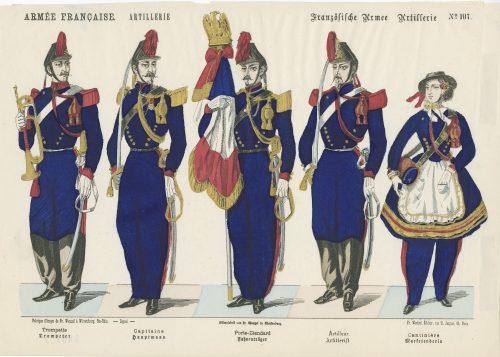 Hand-coloured woodcut on wove paper, 265 x 378 mm; black ink stamp “5051 1” to reverse. Top left: "ARMÉE FRANCAISE. ARTILLERIE"; right: (gothic font) "Französische Armee Artillerie" — "№ 107". Below left: "Fabrique d’Images de Fr. Wentzel à Wissembeurg. Bas-Rhin." — "Déposé" —, centre: "Bilderfabrit von Fr. Wentzel in Weissenburg", right: "Fr. Wentzel, Éditeur, rue St. Jacques, 65, Paris". Bottom: "Trompette | Trompeter" — "Capitaine | Gauptmann" — "Porte-Étendard | Fahnenträger" — "Artilleur | Artillerist" — "Cantinière | Marketenderin". Jean Frédéric Wentzel (French, 1807 – 1869) – publisher/printer.
Hand-coloured woodcut on wove paper, 265 x 378 mm; black ink stamp “5051 1” to reverse. Top left: "ARMÉE FRANCAISE. ARTILLERIE"; right: (gothic font) "Französische Armee Artillerie" — "№ 107". Below left: "Fabrique d’Images de Fr. Wentzel à Wissembeurg. Bas-Rhin." — "Déposé" —, centre: "Bilderfabrit von Fr. Wentzel in Weissenburg", right: "Fr. Wentzel, Éditeur, rue St. Jacques, 65, Paris". Bottom: "Trompette | Trompeter" — "Capitaine | Gauptmann" — "Porte-Étendard | Fahnenträger" — "Artilleur | Artillerist" — "Cantinière | Marketenderin". Jean Frédéric Wentzel (French, 1807 – 1869) – publisher/printer. -
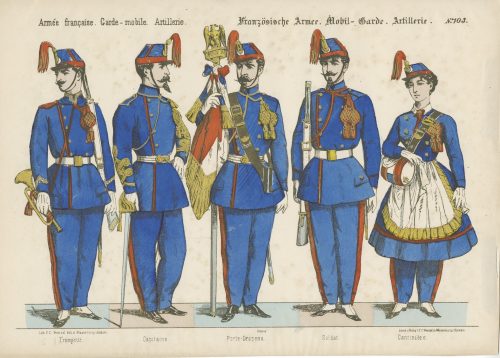 Hand-coloured woodcut on wove paper, 282 x 392 mm; black ink stamp “5051 2” to reverse. Top: "Armée française. Garde–mobile. Artillerie." — (gothic font) "Französische Armee. Mobil–Garde. Artillerie." — "№103". Below left: "Lith F. C. Wentzel édit. à Wissembourg. (Alsacé); center: Déposé; right: Druck u. Verlag v. F. C. Wentzel in Weissemburg. (Elsass)."; Bottom: "Trompette" — "Capitaine" — "Porte-Drapeau". — "Soldat" — "Cantinière." Jean Frédéric Wentzel (French, 1807 – 1869) – publisher/printer.
Hand-coloured woodcut on wove paper, 282 x 392 mm; black ink stamp “5051 2” to reverse. Top: "Armée française. Garde–mobile. Artillerie." — (gothic font) "Französische Armee. Mobil–Garde. Artillerie." — "№103". Below left: "Lith F. C. Wentzel édit. à Wissembourg. (Alsacé); center: Déposé; right: Druck u. Verlag v. F. C. Wentzel in Weissemburg. (Elsass)."; Bottom: "Trompette" — "Capitaine" — "Porte-Drapeau". — "Soldat" — "Cantinière." Jean Frédéric Wentzel (French, 1807 – 1869) – publisher/printer. -
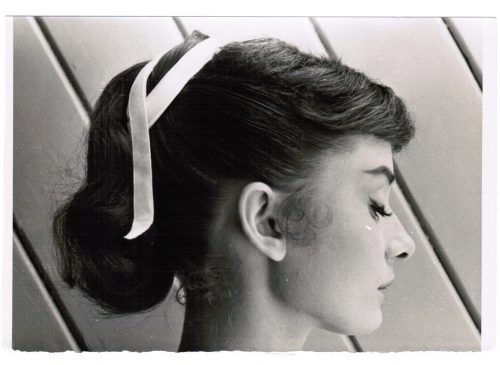 Audrey Hepburn [Audrey Kathleen Ruston] (British, 1929 – 1993) black and white head-shot in profile to right, pre-production photo testing hairstyle. "War and Peace", a 1956 epic historical drama film based on Leo Tolstoy's 1869 novel of the same name. Stamp on verso: Blue ink, in oval, "AUDREY | HEPBURN | The Personal Collection Part III | May 2018 | CHRISTIE'S || Size: 12.0 x 17.5 cm sheet; 12.0 x 16.7 cm image. Condition: small abrasion to cheek and rough lower edge. Certificate of authenticity from John Reznikoff, University Archives.
Audrey Hepburn [Audrey Kathleen Ruston] (British, 1929 – 1993) black and white head-shot in profile to right, pre-production photo testing hairstyle. "War and Peace", a 1956 epic historical drama film based on Leo Tolstoy's 1869 novel of the same name. Stamp on verso: Blue ink, in oval, "AUDREY | HEPBURN | The Personal Collection Part III | May 2018 | CHRISTIE'S || Size: 12.0 x 17.5 cm sheet; 12.0 x 16.7 cm image. Condition: small abrasion to cheek and rough lower edge. Certificate of authenticity from John Reznikoff, University Archives. -
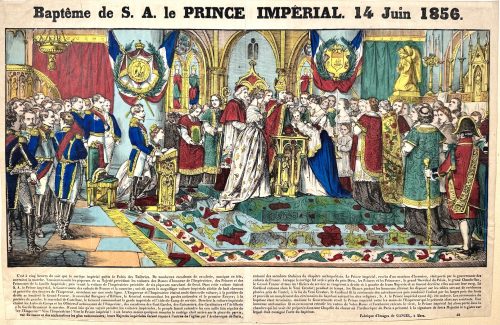 Hand-coloured woodcut on wove paper, 610 x 390 mm; black ink stamp “5207” to reverse, attached to a larger sheet of thick paper with a red ink stamp: “COLLECTION JEAN-CLAUD LACHNITT | REPRODUCTION INTERDIT”. Top: Baptême de S. A. le PRINCE IMPÉRIAL. 14 Juin 1856; image of baptism of Prince-Impérial; two-column text with a small loss in the lower left corner (C'est à cinq heures du soir que le cortège impérial quitta le Palais des Tuileries. De nombreux escadrons de cavalerie, musique en tête ouvraient la marche. ...); bottom under the text: "Fabrique d'Images de GANGEL, à Metz." — "49".
Hand-coloured woodcut on wove paper, 610 x 390 mm; black ink stamp “5207” to reverse, attached to a larger sheet of thick paper with a red ink stamp: “COLLECTION JEAN-CLAUD LACHNITT | REPRODUCTION INTERDIT”. Top: Baptême de S. A. le PRINCE IMPÉRIAL. 14 Juin 1856; image of baptism of Prince-Impérial; two-column text with a small loss in the lower left corner (C'est à cinq heures du soir que le cortège impérial quitta le Palais des Tuileries. De nombreux escadrons de cavalerie, musique en tête ouvraient la marche. ...); bottom under the text: "Fabrique d'Images de GANGEL, à Metz." — "49". -
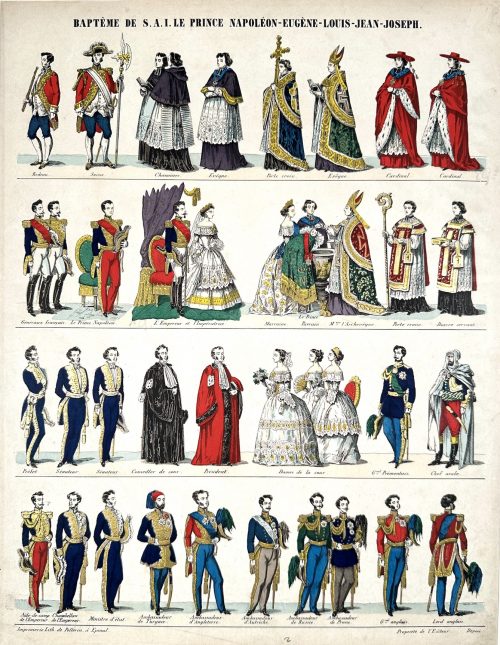 Hand-coloured woodcut on wove paper, 460 x 363 mm; black ink stamp “5054” to reverse. Four tiers with groups of people dressed in uniform, captioned: Bedeau — Suisse — Chanoines — Évêque — Porte croix — Évêque — Cardinal — Cardinal | Généraux français — Le prince Napoléon — L’Empereur et l’Impératrice — Marraine — Le Prince — Parrain | Meur l’Archevêque | Porte crosse Diacre servant | Préfet — Sénateur — Conseiller de cour — Président — Dames de la cour — Gral Piémontais — Chef arabe | Aide-de-camp de l’Empereur — Chambellan de l’Empereur — Ministre d’état — Ambassadeur de Turque | Ambassadeur d’Angleterre — Ambassadeur d’Autriche — Ambassadeur de Russie — Ambassadeur de Prusse — Gral anglaise — Lord anglais || Bottom left: Imprimerie Lith. de Pellerin, à Épinal; right: Propriété de l’Éditeur. — Déposé. Jean Charles Pellerin (French, 1756 – 1836) – printer/publisher.
Hand-coloured woodcut on wove paper, 460 x 363 mm; black ink stamp “5054” to reverse. Four tiers with groups of people dressed in uniform, captioned: Bedeau — Suisse — Chanoines — Évêque — Porte croix — Évêque — Cardinal — Cardinal | Généraux français — Le prince Napoléon — L’Empereur et l’Impératrice — Marraine — Le Prince — Parrain | Meur l’Archevêque | Porte crosse Diacre servant | Préfet — Sénateur — Conseiller de cour — Président — Dames de la cour — Gral Piémontais — Chef arabe | Aide-de-camp de l’Empereur — Chambellan de l’Empereur — Ministre d’état — Ambassadeur de Turque | Ambassadeur d’Angleterre — Ambassadeur d’Autriche — Ambassadeur de Russie — Ambassadeur de Prusse — Gral anglaise — Lord anglais || Bottom left: Imprimerie Lith. de Pellerin, à Épinal; right: Propriété de l’Éditeur. — Déposé. Jean Charles Pellerin (French, 1756 – 1836) – printer/publisher. -
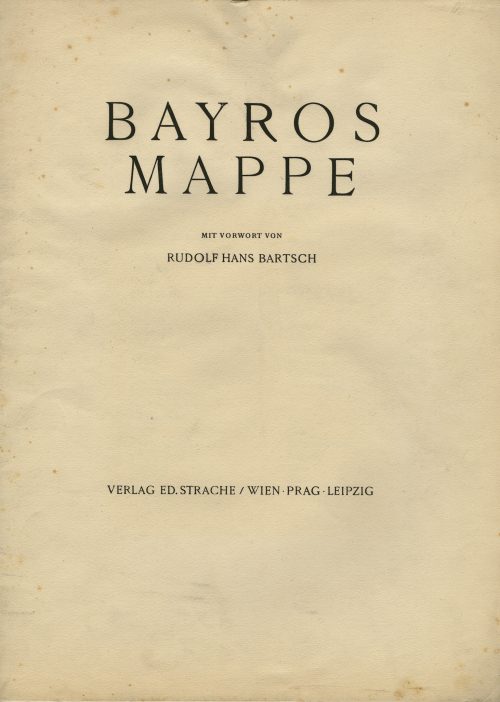 An album 45 of 50 prints, 31 photogravures and 14 in raster chromotype after drawings and paintings by Franz von Bayros; most with tissue guards, some in passepartout; colour prints mounted on the same paper that is used for photogravures. Title-page: BAYROS | MAPPE | MIT VORWORT VON | RUDOLF HANS BARTSCH | VERLAG ED. STRACHE / WIEN • PRAG • LEIPZIG || Limited edition of 500 copies. This is copy № 286. Lacking 5 prints: (1) Abschied vom Paradies, (2) Weihnacht, and (3) Harmonie from Symphonie von der Gūte, die Schönheit ist; (4) Divina commedia from Florentiner Phantasien; and (5) Mozart from Varia. Contributors: Franz von Bayros (Austrian, 1866 – 1924) Rudolf Hans Bartsch (Austrian, 1873 – 1952)
An album 45 of 50 prints, 31 photogravures and 14 in raster chromotype after drawings and paintings by Franz von Bayros; most with tissue guards, some in passepartout; colour prints mounted on the same paper that is used for photogravures. Title-page: BAYROS | MAPPE | MIT VORWORT VON | RUDOLF HANS BARTSCH | VERLAG ED. STRACHE / WIEN • PRAG • LEIPZIG || Limited edition of 500 copies. This is copy № 286. Lacking 5 prints: (1) Abschied vom Paradies, (2) Weihnacht, and (3) Harmonie from Symphonie von der Gūte, die Schönheit ist; (4) Divina commedia from Florentiner Phantasien; and (5) Mozart from Varia. Contributors: Franz von Bayros (Austrian, 1866 – 1924) Rudolf Hans Bartsch (Austrian, 1873 – 1952) -
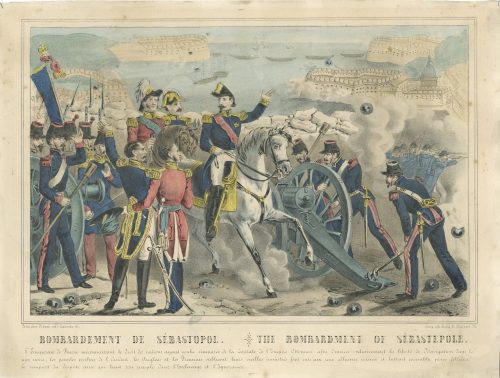 Hand-coloured lithography on wove paper, 250 x 332 mm; black ink stamp “5035” to reverse. Under the frame left: "Paris, chez Riboni, éd. r. Galande, 51"; right: "Paris, lith. Bulla, Pl. Maubert, 26". Below: "BOMBARDEMENT DE SEBASTOPOL. — THE BOMBARDMENT OF SÉBASTOPOLE". Text to bottom. Printers/publishers: Antoine Bulla (fl. 1815 – 1877), François Bulla (fl. c. 1814 – 1855).
Hand-coloured lithography on wove paper, 250 x 332 mm; black ink stamp “5035” to reverse. Under the frame left: "Paris, chez Riboni, éd. r. Galande, 51"; right: "Paris, lith. Bulla, Pl. Maubert, 26". Below: "BOMBARDEMENT DE SEBASTOPOL. — THE BOMBARDMENT OF SÉBASTOPOLE". Text to bottom. Printers/publishers: Antoine Bulla (fl. 1815 – 1877), François Bulla (fl. c. 1814 – 1855). -
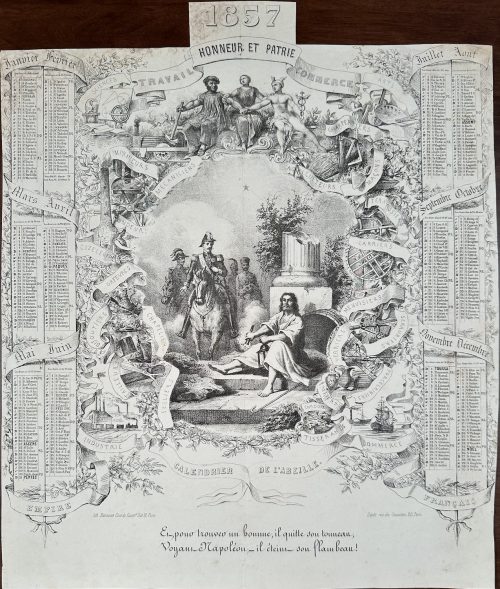 Lithography and etching on wove paper432 x 362 mm, black ink stamp “5022” to reverse, horizontal and vertical centrefolds. Depicts Diogenes (Ancient Greek, 412/404 – 323 BC) beside his barrel and extinguishing his torch when approached by Napoléon III ahorseback. Top: "1857 | HONNEUR ET PATRIE"; lettering on ribbons (top-down): SCIENCES, TRAVAIL, COMMERCE, ARTS, CHARPENTIERS, IMPRIMEURS, "MECHANICIENS, AGRICULTEURS, MAÇONS, FONDEURS, TERRASIERS, CIZELEURS, CARRIERS, ORFEVRES, BIJOUTIERS, CHAPELIERS, MENUISIERS, VERRIERS, SERRURIERS, TAILLEURS, SELLIERS, POTIERS, PORCELAINIERS, CORDONNIERS, TISSERANDS, INDUSTRIE, COMMERCE | CALENDRIER DE L'ABEILLE | EMPIRE, FRANÇAIS. Below left: "lith. Barousse Cour du Comm. 11 et 12. Paris"; right: "Dépôt rue des Cannettes, 20. Paris"; bottom: "Et, pour trouver un homme, il quitte son tonneau, | Voyant Napoléon, – il éteint son flambeau!" [And, to find a man, he leaves his barrel, | Seeing Napoleon, – he extinguishes his torch!]. Six months on the left and six months on the right-hand side of the calendar, surrounding the image.
Lithography and etching on wove paper432 x 362 mm, black ink stamp “5022” to reverse, horizontal and vertical centrefolds. Depicts Diogenes (Ancient Greek, 412/404 – 323 BC) beside his barrel and extinguishing his torch when approached by Napoléon III ahorseback. Top: "1857 | HONNEUR ET PATRIE"; lettering on ribbons (top-down): SCIENCES, TRAVAIL, COMMERCE, ARTS, CHARPENTIERS, IMPRIMEURS, "MECHANICIENS, AGRICULTEURS, MAÇONS, FONDEURS, TERRASIERS, CIZELEURS, CARRIERS, ORFEVRES, BIJOUTIERS, CHAPELIERS, MENUISIERS, VERRIERS, SERRURIERS, TAILLEURS, SELLIERS, POTIERS, PORCELAINIERS, CORDONNIERS, TISSERANDS, INDUSTRIE, COMMERCE | CALENDRIER DE L'ABEILLE | EMPIRE, FRANÇAIS. Below left: "lith. Barousse Cour du Comm. 11 et 12. Paris"; right: "Dépôt rue des Cannettes, 20. Paris"; bottom: "Et, pour trouver un homme, il quitte son tonneau, | Voyant Napoléon, – il éteint son flambeau!" [And, to find a man, he leaves his barrel, | Seeing Napoleon, – he extinguishes his torch!]. Six months on the left and six months on the right-hand side of the calendar, surrounding the image. -
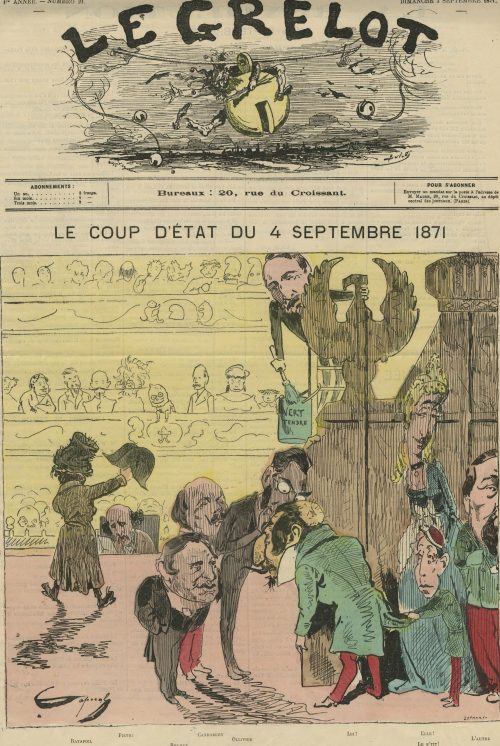 Le Grelot / journal illustré politique et satirique, №21, dimanche, 3 septembre 1871. Artist: Caporal (signed in the lower-left corner) Engraver/Printer: J. Lefman (signed LEFMAN SC in the lower-right corner) Title: LE COUP D'ÉTAT DU 4 SEPTEMBRE 1871. The Coup d'Etat of September 4th 1871. The artist equalled the 4th of September revolution when Napoleon III was ousted and the Second Empire collapsed, to a coup d'Etat. Although the number is marked September 3, it is dedicated to the events of September 4th. This was a usual French newspaper practice to postdate their issues. That's why they almost always operated with categories such as "today", "yesterday", and "tomorrow" instead of definitive calendar dates. "Le Grelot" means "The Sleigh Bell". Personages: Ratapoil – fictional personage invented by Honoré Daumier (French, 1808 – 1879), a Napoleon III caricaturized figure. Ratapoil is addressing the audience holding up Napoléon Bonaparte's tricorn cocked hat. Pietri – Joseph Marie Piétri [Joachim Piétri] (French, – is sitting in the first row, taking notes. Rouher – Eugène Rouher (French, 1814 – 1884), president of the Senat. Canrobert – François Marcellin Certain de Canrobert (French, 1809 – 1895), French Marshal, captured by the Prussian army in Metz with Marshal Bazaine during the surrender of Metz on October 28, 1870. Ollivier – Olivier Émile Ollivier (French, 1825 – 1913), head of the government. Hiding behind the theater decoration are: Napoleon III (Lui!), his wife Eugénie (Elle!), their son Prince Imperial (Le P'tit!), and Pierre Bonaparte (L'Autre). Sitting in the theatre box facing the scene: Adolphe Thiers (French, 1797 – 1877), Jules Favre (French, 1809 – 1880), Louis-Jules Trochu [Le General Trochu] (French, 1815 – 1896), and the other members of the "Government of National Defence". On the gallery: youngsters and two men in sans-culottes hats. An unidentified person on a ladder holding to an eagle figure is having a paintbrush and a bucket with 'tender green' paint. Ref: Musée Carnavalet
Le Grelot / journal illustré politique et satirique, №21, dimanche, 3 septembre 1871. Artist: Caporal (signed in the lower-left corner) Engraver/Printer: J. Lefman (signed LEFMAN SC in the lower-right corner) Title: LE COUP D'ÉTAT DU 4 SEPTEMBRE 1871. The Coup d'Etat of September 4th 1871. The artist equalled the 4th of September revolution when Napoleon III was ousted and the Second Empire collapsed, to a coup d'Etat. Although the number is marked September 3, it is dedicated to the events of September 4th. This was a usual French newspaper practice to postdate their issues. That's why they almost always operated with categories such as "today", "yesterday", and "tomorrow" instead of definitive calendar dates. "Le Grelot" means "The Sleigh Bell". Personages: Ratapoil – fictional personage invented by Honoré Daumier (French, 1808 – 1879), a Napoleon III caricaturized figure. Ratapoil is addressing the audience holding up Napoléon Bonaparte's tricorn cocked hat. Pietri – Joseph Marie Piétri [Joachim Piétri] (French, – is sitting in the first row, taking notes. Rouher – Eugène Rouher (French, 1814 – 1884), president of the Senat. Canrobert – François Marcellin Certain de Canrobert (French, 1809 – 1895), French Marshal, captured by the Prussian army in Metz with Marshal Bazaine during the surrender of Metz on October 28, 1870. Ollivier – Olivier Émile Ollivier (French, 1825 – 1913), head of the government. Hiding behind the theater decoration are: Napoleon III (Lui!), his wife Eugénie (Elle!), their son Prince Imperial (Le P'tit!), and Pierre Bonaparte (L'Autre). Sitting in the theatre box facing the scene: Adolphe Thiers (French, 1797 – 1877), Jules Favre (French, 1809 – 1880), Louis-Jules Trochu [Le General Trochu] (French, 1815 – 1896), and the other members of the "Government of National Defence". On the gallery: youngsters and two men in sans-culottes hats. An unidentified person on a ladder holding to an eagle figure is having a paintbrush and a bucket with 'tender green' paint. Ref: Musée Carnavalet -
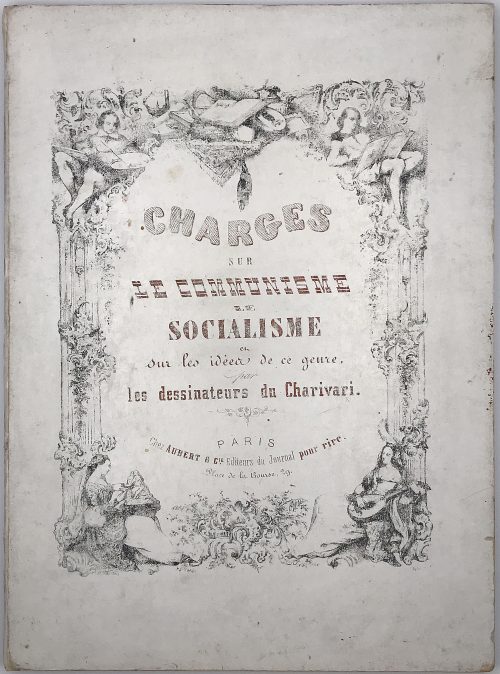 Charges sur le Communisme, le socialisme et sur les idées de ce genre par les dessinateurs du Charivari. Binding: original cardboard. Catalogue raisonée: Hazard & Delteil 1904 / Catalogue raisonné de l'oeuvre lithographié de Honoré Daumier [LIB-2176.2019 in this collection], p. 267: 20 illustrations by Daumier, Cham, Vernier, Ed. de Beaumont. Sticker: Vendu par Francois, Grande-Rue №33, à Rouen. Bought in Paris, seller claimed 1848, first edition. Similar title here : #31. Charges sur le communisme Le socialisme et sur les idées de ce genre par les dessinateurs. Paris, Chez Aubert & Cie., Éditeurs du Journal pour rire, sans date (vers 1865). Relié, plein cartonnage vert décoré et illustré de l'éditeur, in-folio (34,5 x 26 cm) de 20 planches lithographiées. 250 €. Caricatures par Cham (11), Gustave Janet (1), ADC (1), sans nom (3), Daumier (1), Lorentz-Jean-Paul Laurens (3). Nous trouvons pour ce même cartonnage des recueils différents à diverses périodes ; le nôtre doit dater des années 1865-67, moment où Jean-Pierre Laurens fut condamné par la justice du Second Empire pour son anticléricalisme.
Charges sur le Communisme, le socialisme et sur les idées de ce genre par les dessinateurs du Charivari. Binding: original cardboard. Catalogue raisonée: Hazard & Delteil 1904 / Catalogue raisonné de l'oeuvre lithographié de Honoré Daumier [LIB-2176.2019 in this collection], p. 267: 20 illustrations by Daumier, Cham, Vernier, Ed. de Beaumont. Sticker: Vendu par Francois, Grande-Rue №33, à Rouen. Bought in Paris, seller claimed 1848, first edition. Similar title here : #31. Charges sur le communisme Le socialisme et sur les idées de ce genre par les dessinateurs. Paris, Chez Aubert & Cie., Éditeurs du Journal pour rire, sans date (vers 1865). Relié, plein cartonnage vert décoré et illustré de l'éditeur, in-folio (34,5 x 26 cm) de 20 planches lithographiées. 250 €. Caricatures par Cham (11), Gustave Janet (1), ADC (1), sans nom (3), Daumier (1), Lorentz-Jean-Paul Laurens (3). Nous trouvons pour ce même cartonnage des recueils différents à diverses périodes ; le nôtre doit dater des années 1865-67, moment où Jean-Pierre Laurens fut condamné par la justice du Second Empire pour son anticléricalisme. -
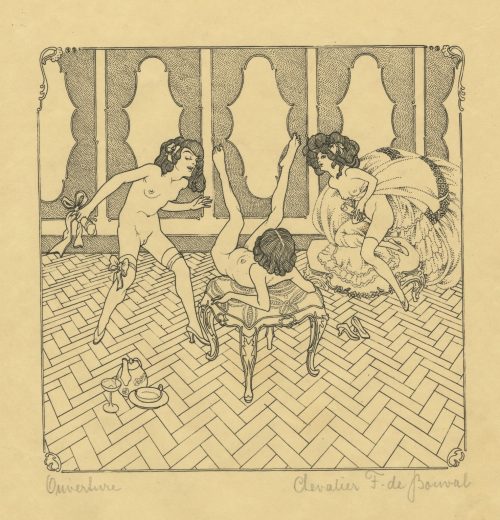 A set of sixteen planographic prints, signed and titled in pencil by owner “Chevalier F. de Bouval” (pseudonym of Franz von Bayros (Austrian, 1866 – 1924). Titles include: 1) Ouverture, 2) champagne brut, 3) maternité, 4) piano, 5) crudité délicieuse, 6. la belle vue, 7) au pensionnat, 8) le collier, 9) languelles pénètrelles, 10) introduction, 11) le sourrogat, 12) variation amoureuse, 13) la surprise, 14) le clef délicat, 15) le monstre gomme, 16) fruits de sud. Printed on wove paper, possibly engraved on wood after ink drawings by Franz von Bayros (Austrian, 1866 – 1924) under the pseudonym Chevalier F. de Bouval. Size: sheet 30 x 24 cm, image 18 x 17.5 cm. In another source, there are two more images from the same set: le passe-partout and la doublette, making 18 images altogether; the set is titled “Lesbia: XVIII sujets”, signed by Chevalier François René de Bouval.
A set of sixteen planographic prints, signed and titled in pencil by owner “Chevalier F. de Bouval” (pseudonym of Franz von Bayros (Austrian, 1866 – 1924). Titles include: 1) Ouverture, 2) champagne brut, 3) maternité, 4) piano, 5) crudité délicieuse, 6. la belle vue, 7) au pensionnat, 8) le collier, 9) languelles pénètrelles, 10) introduction, 11) le sourrogat, 12) variation amoureuse, 13) la surprise, 14) le clef délicat, 15) le monstre gomme, 16) fruits de sud. Printed on wove paper, possibly engraved on wood after ink drawings by Franz von Bayros (Austrian, 1866 – 1924) under the pseudonym Chevalier F. de Bouval. Size: sheet 30 x 24 cm, image 18 x 17.5 cm. In another source, there are two more images from the same set: le passe-partout and la doublette, making 18 images altogether; the set is titled “Lesbia: XVIII sujets”, signed by Chevalier François René de Bouval. -
 Woodblock print album of thirteen prints, ōban, nishiki-e. Artist: Chōkyōsai Eiri [鳥橋斎 栄里] (Japanese, fl. c. 1789 ~ 1801 ). Models of calligraphy (Fumi no kiyogaki), New Year 1801. This title is taken from Chris Uhlenbeck's Japanese Erotic Fantasies Sexual Imagery of the Edo Period. — Hotei Publishing, 2005, ISBN 90-74822-66-5):. A detailed description of the album can be found at The Complete Ukiyo-e Shunga №9 Eiri, 1996, ISBN 4-309-91019. Most of the edition is in Japanese, though Richard Lane writes a section in English: Eiri: Love-letters, Love Consummated: Fumi-no-kiyogaki. The article starts with the following statement: "Why all the fuss about Sharaku? Because he is so "mysterious"? No, not at all: because he is such a good artist. But Sharaku is not the only great yet enigmatic ukiyo-e artist and I propose to resurrect here one of his important contemporaries who has been all too long neglected: Chōkyōsai Eiri. As with many of the notable ukiyo-e masters, nothing is known of Eiri's biography. All we can say is what we learn from his extant prints and paintings: that he flourished during the second half of the Kansei Period [1789-1801]; and that he was a direct pupil of the great Eishi - who, being of eminent samurai stock, may well have attracted pupils of similar background." Another citation from Japanese Erotic Fantasies: "This album is one of the boldest sets of ōban-size shunga known, The first edition contains thirteen instead of the customary twelve designs". Here I present all thirteen prints, though the edition I bought in Kyoto in 2014 contained only twelve. The thirteenth print was purchased later in the United States (sheet №12).
Woodblock print album of thirteen prints, ōban, nishiki-e. Artist: Chōkyōsai Eiri [鳥橋斎 栄里] (Japanese, fl. c. 1789 ~ 1801 ). Models of calligraphy (Fumi no kiyogaki), New Year 1801. This title is taken from Chris Uhlenbeck's Japanese Erotic Fantasies Sexual Imagery of the Edo Period. — Hotei Publishing, 2005, ISBN 90-74822-66-5):. A detailed description of the album can be found at The Complete Ukiyo-e Shunga №9 Eiri, 1996, ISBN 4-309-91019. Most of the edition is in Japanese, though Richard Lane writes a section in English: Eiri: Love-letters, Love Consummated: Fumi-no-kiyogaki. The article starts with the following statement: "Why all the fuss about Sharaku? Because he is so "mysterious"? No, not at all: because he is such a good artist. But Sharaku is not the only great yet enigmatic ukiyo-e artist and I propose to resurrect here one of his important contemporaries who has been all too long neglected: Chōkyōsai Eiri. As with many of the notable ukiyo-e masters, nothing is known of Eiri's biography. All we can say is what we learn from his extant prints and paintings: that he flourished during the second half of the Kansei Period [1789-1801]; and that he was a direct pupil of the great Eishi - who, being of eminent samurai stock, may well have attracted pupils of similar background." Another citation from Japanese Erotic Fantasies: "This album is one of the boldest sets of ōban-size shunga known, The first edition contains thirteen instead of the customary twelve designs". Here I present all thirteen prints, though the edition I bought in Kyoto in 2014 contained only twelve. The thirteenth print was purchased later in the United States (sheet №12). №1: "...one of the most exotic scenes in all shunga. A Dutch kapitan is discovered coupling with a lovely Japanese courtesan, beside a large window opening upon a garden...".
№1: "...one of the most exotic scenes in all shunga. A Dutch kapitan is discovered coupling with a lovely Japanese courtesan, beside a large window opening upon a garden...".

 №2: "...a fair young harlot is seen masturbating with a grinding-pestle - a man watches intently from under bedding." [I have two specimens of this design; the one from album is more soiled but less faded].
№2: "...a fair young harlot is seen masturbating with a grinding-pestle - a man watches intently from under bedding." [I have two specimens of this design; the one from album is more soiled but less faded].
 №3: "...the artist has effectively contrasted the lovers by depicting the man's face as seen through the geisha's gauze skirt. [...] we are impressed more by strikingly elegant composition, the dramatic coloring, rather than feeling any great urge to participate in the energetic proceedings..."
№3: "...the artist has effectively contrasted the lovers by depicting the man's face as seen through the geisha's gauze skirt. [...] we are impressed more by strikingly elegant composition, the dramatic coloring, rather than feeling any great urge to participate in the energetic proceedings..."
 №4: "This scene is a most straightforward one, featuring the standard Missionary Position [capitalization by R. Lane].; but withal, the contrast of the young and naked, secret lover and the richly-clothed courtesan amid luxurious bedding..."
№4: "This scene is a most straightforward one, featuring the standard Missionary Position [capitalization by R. Lane].; but withal, the contrast of the young and naked, secret lover and the richly-clothed courtesan amid luxurious bedding..."
 №5: "In a striking lesbian scene (which has no equivalent in Utamaro, and is, incidentally, often omitted in later editions of this album), the girl at left prepares to receive the harikata (dildo) worn by the older girl at right (who holds a seashell containing lubricant)."
№5: "In a striking lesbian scene (which has no equivalent in Utamaro, and is, incidentally, often omitted in later editions of this album), the girl at left prepares to receive the harikata (dildo) worn by the older girl at right (who holds a seashell containing lubricant)."
 №6: "In the first appearance of a matronly heroine in this series, we find a widow - with shaven eyebrows and clipped hair - sporting with a handsome yound shop-clerk, mounting him with all her might."
№6: "In the first appearance of a matronly heroine in this series, we find a widow - with shaven eyebrows and clipped hair - sporting with a handsome yound shop-clerk, mounting him with all her might."

 №7: "... lady of samurai court: here, shown taking advantage of an official outing to temple and theatre, to rendezvous with a secret lover on a teahouse balcony." R. Lane considers this design the least successful in the series, especially in comparison with the same theme by Utamaro: "Utamaro female is almost ferocious in her lust for sexual gratification", which does not sound true to me. See Utamaro's sheet №5 from the album Utamakura (歌まくら, Poem of the Pillow) [courtesy The British Museum without permission]:
№7: "... lady of samurai court: here, shown taking advantage of an official outing to temple and theatre, to rendezvous with a secret lover on a teahouse balcony." R. Lane considers this design the least successful in the series, especially in comparison with the same theme by Utamaro: "Utamaro female is almost ferocious in her lust for sexual gratification", which does not sound true to me. See Utamaro's sheet №5 from the album Utamakura (歌まくら, Poem of the Pillow) [courtesy The British Museum without permission]:
 Then, as Richard Lane states, "we are flung suddenly to the bottom rung of Edo society":
Then, as Richard Lane states, "we are flung suddenly to the bottom rung of Edo society":
 №8: "Here we find a fair yotaka ('night-hawk', e.i. streetwalker) accommodating a lusty client in a lumberyard by the bank of the Sumida River".
№8: "Here we find a fair yotaka ('night-hawk', e.i. streetwalker) accommodating a lusty client in a lumberyard by the bank of the Sumida River".
 №9: '... a slightly plump harlot of the lower class receives a night visit from her lover, whose naked form she tries to cover with a cloak."
№9: '... a slightly plump harlot of the lower class receives a night visit from her lover, whose naked form she tries to cover with a cloak."
 №10: "...likely maidservant and lackey - are depicted in bath-room, their passions are all too obviously fired by steaming water."
№10: "...likely maidservant and lackey - are depicted in bath-room, their passions are all too obviously fired by steaming water."
 №11: "...this scene of courtesan and secret lover ranks high not only in Eiri's œuvre but also in the annals of the ukiyo-e genre itself. Both design and colouring are impeccable and, for this period, there is nothing even in the work of great Utamaro that really surpasses it." Again, a doubtful statement, however, this is Utamaro's design for the reader to judge:
№11: "...this scene of courtesan and secret lover ranks high not only in Eiri's œuvre but also in the annals of the ukiyo-e genre itself. Both design and colouring are impeccable and, for this period, there is nothing even in the work of great Utamaro that really surpasses it." Again, a doubtful statement, however, this is Utamaro's design for the reader to judge:
 The last design in my album is this:
The last design in my album is this:
 #13: In most reference books it goes under number 13, and we will assign this number to the sheet. "The final scene of the album features naked participants, probably samurai man and wife. The print is rather subdued in tone and colour, if not in the degree of the passion displayed..."
An additional sheet, acquired separately from a reputable dealer in New York, is usually listed as №12:
#13: In most reference books it goes under number 13, and we will assign this number to the sheet. "The final scene of the album features naked participants, probably samurai man and wife. The print is rather subdued in tone and colour, if not in the degree of the passion displayed..."
An additional sheet, acquired separately from a reputable dealer in New York, is usually listed as №12:
 №12: "One might think that Eiri has reached his peak with the preceding plate 11 - and indeed he has, in both esthetic and erotic terms. But the album is not yet finished, and the next scene lends a needed variety to the series, a slightly comic tableau featuring a middle-aged lackey attempting to forcibly seduce a servant girl of the same domicile". Utamaro's design, that inspired Eiri is here:
№12: "One might think that Eiri has reached his peak with the preceding plate 11 - and indeed he has, in both esthetic and erotic terms. But the album is not yet finished, and the next scene lends a needed variety to the series, a slightly comic tableau featuring a middle-aged lackey attempting to forcibly seduce a servant girl of the same domicile". Utamaro's design, that inspired Eiri is here:
 All descriptions are taken from Richard Lane's article at The Complete Ukiyo-e Shunga №9 Eiri, 1996. He concluded: "...Eiri's erotic series represents a major contribution to shunga art towards the close of ukiyo-e "Golden Age". In part inspired by Utamaro's classic album, this series withal constitutes a unified and original achievement, providing a cumulative effect of gracefully elegant yet glowing eroticism, which remains in the mind's eye long after the pictures themselves are far away."
I only would like to mention here that in several reference sources this album goes under name of Eisho; unfortunately, this mistake is reproduced at www.ukiyo-e.org, which miraculously shows exactly my print, but under the wrong name of the artist. The same mistake can be found at Shunga. The art of love in Japan. Tom and Mary Anne Evans. Paddington Press Ltd., 1975. ISBN 0-8467-0066-2; plates 6.74-6.77: Chōkyōsai Eishō, c. 1800. Even the British Museum edition of 2010 gives the same erroneous attribution: Chōkyōsai Eishō (1793-1801); they provide the following translation of title: "Clean Draft of a Letter" [see: Shunga. Erotic art in Japan. Rosina Buckland. The British Museum Press, 2010; pp. 110-112]. To the honour of the British Museum, I must admit that they have corrected themselves in Shunga. Sex and pleasure in Japanese art. Edited by Timothy Clark, et al. Hotei Publishing, 2013. Now, they say Chōkyōsai Eiri (worked c. 1790s-1801); they also provide a new title: "Neat Version of the Love Letter, or Pure Drawings of Female Beauty". I have already mentioned Richard Lane's version of title: "Love-letters, Love Consummated", and Chris Uhlenbeck's "Models of calligraphy". In poorly designed and printed Shunga. Erotic figures in Japanese art. Presented by Gabriele Mandel. Translated by Alison L'Eplattenier. Crescent Books, New York, 1983, the artist is named Shokyosai Eisho (beginning of the 19th century); title provided: "Models of Calligraphy". Correct attribution to Chōkyōsai Eiri also can be found at Poem of the pillow and other stories by Utamaro, Hokusai, Kuniyoshi and other artists of the floating world. Gian Carlo Calza in collaboration with Stefania Piotti. Phaidon Press, 2010; though the title is translated as "Clean Copy of Female Beauty".
All descriptions are taken from Richard Lane's article at The Complete Ukiyo-e Shunga №9 Eiri, 1996. He concluded: "...Eiri's erotic series represents a major contribution to shunga art towards the close of ukiyo-e "Golden Age". In part inspired by Utamaro's classic album, this series withal constitutes a unified and original achievement, providing a cumulative effect of gracefully elegant yet glowing eroticism, which remains in the mind's eye long after the pictures themselves are far away."
I only would like to mention here that in several reference sources this album goes under name of Eisho; unfortunately, this mistake is reproduced at www.ukiyo-e.org, which miraculously shows exactly my print, but under the wrong name of the artist. The same mistake can be found at Shunga. The art of love in Japan. Tom and Mary Anne Evans. Paddington Press Ltd., 1975. ISBN 0-8467-0066-2; plates 6.74-6.77: Chōkyōsai Eishō, c. 1800. Even the British Museum edition of 2010 gives the same erroneous attribution: Chōkyōsai Eishō (1793-1801); they provide the following translation of title: "Clean Draft of a Letter" [see: Shunga. Erotic art in Japan. Rosina Buckland. The British Museum Press, 2010; pp. 110-112]. To the honour of the British Museum, I must admit that they have corrected themselves in Shunga. Sex and pleasure in Japanese art. Edited by Timothy Clark, et al. Hotei Publishing, 2013. Now, they say Chōkyōsai Eiri (worked c. 1790s-1801); they also provide a new title: "Neat Version of the Love Letter, or Pure Drawings of Female Beauty". I have already mentioned Richard Lane's version of title: "Love-letters, Love Consummated", and Chris Uhlenbeck's "Models of calligraphy". In poorly designed and printed Shunga. Erotic figures in Japanese art. Presented by Gabriele Mandel. Translated by Alison L'Eplattenier. Crescent Books, New York, 1983, the artist is named Shokyosai Eisho (beginning of the 19th century); title provided: "Models of Calligraphy". Correct attribution to Chōkyōsai Eiri also can be found at Poem of the pillow and other stories by Utamaro, Hokusai, Kuniyoshi and other artists of the floating world. Gian Carlo Calza in collaboration with Stefania Piotti. Phaidon Press, 2010; though the title is translated as "Clean Copy of Female Beauty".
-
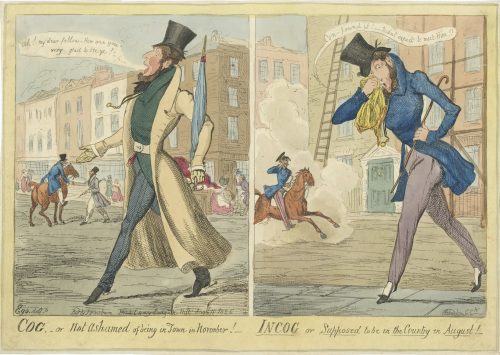 Description by British Museum (1865,1111.2128): "Two designs, side by side. [1] A dandy (probably a portrait), florid, whiskered, and bearded, steps jauntily from the pavement, hand extended, saying: Ah! my dear fellow — How are you? Devilish glad to see ye!— He holds a closed umbrella, ferrule erect, and wears a long tight-waisted coat to the heels, unbuttoned, tight pantaloons and spurred boots. In the middle distance, another dandy grasps the hand of a friend on horseback. Behind are houses with shop-fronts. A man raises his hat to a lady who curtseys. [2] The same dandy steps from the roadway onto the pavement, his handkerchief to his nose; he stoops, trying to conceal himself from a dandy cantering past in a cloud of dust, his eye-glass to his eye. He is without gloves, extraordinary for a dandy, and his trousers are strapped over pumps; he says: Con-found it! — Didn't expect to meet Him!! The street is otherwise empty; against the (large) houses are scaffolding and a tall ladder." Lettered with title, text within image including production details: 'Ego. delt / Etched by G. Ck / Pubd by J Fairburn Broadway Ludgate Hill August 18 1826'. Dimensions: Sheet: 25.5 x 36 cm, Image: 21.7 x 33.8 cm. Catalogue raisonné: A. M. Cohn (1924): № 1001, p. 262.: "A wretched plate. Difficult to believe G. C. had anything to do with it." — Bruton. Value.— £1.
Description by British Museum (1865,1111.2128): "Two designs, side by side. [1] A dandy (probably a portrait), florid, whiskered, and bearded, steps jauntily from the pavement, hand extended, saying: Ah! my dear fellow — How are you? Devilish glad to see ye!— He holds a closed umbrella, ferrule erect, and wears a long tight-waisted coat to the heels, unbuttoned, tight pantaloons and spurred boots. In the middle distance, another dandy grasps the hand of a friend on horseback. Behind are houses with shop-fronts. A man raises his hat to a lady who curtseys. [2] The same dandy steps from the roadway onto the pavement, his handkerchief to his nose; he stoops, trying to conceal himself from a dandy cantering past in a cloud of dust, his eye-glass to his eye. He is without gloves, extraordinary for a dandy, and his trousers are strapped over pumps; he says: Con-found it! — Didn't expect to meet Him!! The street is otherwise empty; against the (large) houses are scaffolding and a tall ladder." Lettered with title, text within image including production details: 'Ego. delt / Etched by G. Ck / Pubd by J Fairburn Broadway Ludgate Hill August 18 1826'. Dimensions: Sheet: 25.5 x 36 cm, Image: 21.7 x 33.8 cm. Catalogue raisonné: A. M. Cohn (1924): № 1001, p. 262.: "A wretched plate. Difficult to believe G. C. had anything to do with it." — Bruton. Value.— £1. -
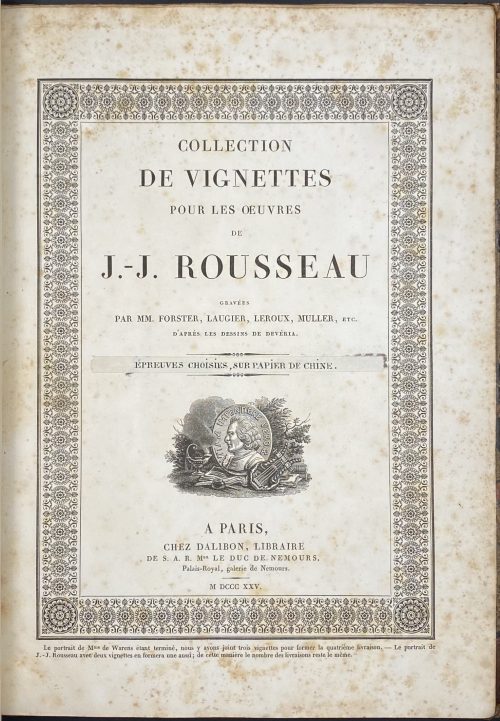 Pictorial album of 41 etchings, incl. two portraits, by various engravers after Achille Devéria, printed on India paper (after letters) and pasted on thick wove paper, bound with tissue guards in half calf over marbled boards bordered gilt, spine decorated gilt, marbled endpapers; base paper and tissue guards are substantially foxed, images mostly intact. The title page and the subscription page are bound-in at the beginning and at the end, respectively. Title page: (in ornamental frame): COLLECTION | DE VIGNETTES | POUR LES ŒUVRES | DE | J.-J. ROUSSEAU | GRAVÉES | PAR MM. FORSTER, LAUGIER, LEROUX, MULLER, ETC. | D'APRÈS LES DESSINS DE DEVÉRIA. | (pasted over) ÉPREUVES CHOISIES, SUR PAPIER DE CHINE. | {publisher’s device} | A PARIS, | CHEZ DALIBON, LIBRAIRE | DE S. A. R. MGR LE DUC DE NEMOURS, | Palais-Royal, galerie de Nemours. | M DCCC XXV. | Under the frame: Le portrait de Mme de Warens étant terminé, nous y avons joint trois vignettes pour former la quatrième livraison. — Le portrait de | J.-J. Rousseau avec deux vignettes en formera une aussi ; de cette manière le nombre des livraisons reste le même. || This collection was published by Dalibon the same year as the 25-volume Rousseau's Œuvres completes. Related persons: Jean-Jacques Rousseau (French, 1712 – 1778). Mme de Warens: Françoise-Louise de Warens [Louise Éléonore de la Tour du Pil] Swiss, 1699 – 1762). S.A.R. Mgr Le Duc de Nemours: Prince Louis of Orléans, Duke of Nemours [Louis Charles Philippe Raphaël d'Orléans] (French, 1814 – 1896). Contributors: François-Denis Dalibon (French, 1794 – 1853) – publisher. L'Imprimerie de Rignoux (Paris); Thomas-François Rignoux (1781 – 1863?) – printer. Achille Devéria (French, 1800 – 1857) – artist. Engravers : François Forster (French, 1790 – 1872) Jean Nicolas Laugier (French, 1785 – 1875) Jean Marie Leroux (French, 1788 – 1871) Henri Charles Müller (French, 1784 – 1845) Herbert König (German, 1820 – 1876) Louis Jean Désiré Delaistre (French, 1800 – 1871) Jean Louis Toussaint Caron (French, 1790 – 1832) Pierre Michel Adam (French, 1799 – 1853) Ferdinand Sébastien Goulu (French, 1796 – 1848) Jean-François Pourvoyeur (French, 1784 – 1851) Jean Baptiste Touzé (French, fl. 1810 – 1830) Narcisse Lecomte (French, 1794 – 1882) Louis Hercule Sisco (French, 1778 – 1861) Edme Jean Ruhierre (French, 1789 – fl. 1826) Auguste Thomas Marie Blanchard (French, 1819 – 1898) François Manceau (French, 1768 – after 1837) Gabriel Louis Lacour-Lestudier (French, 1800 – 1849) Fulley [Frilley?] Jean Jacques Frilley (French, 1797 – after 1850) Philippe Joseph Augustin Vallot (French, 1796 – 1870) Etienne Devilliers (French, 1784 – after 1844) Jean Bosq (French, fl. c. 1801 – 1844) Zachée Prévost (French, 1797 – 1861) Jean Baptiste Guyard II (French, 1787 – 1831/32) Antoine François Gelée (French, 1796-1860) Constant Louis Antoine Lorichon (French, 1800-1856?) Antoine Joseph Chollet (French, 1793 – after 1848) Adrien Migneret (French, 1786 – 1840) Alfred Johannot (French, 1800 – 1837) Arnold Jéhotte (French, 1789 – 1836) Hippolyte Prudhomme (French, 1793 – 1853) Achille Lefèvre (French, 1798 – 1864) Pierre Pelée (French, 1801 – 1871) Antoine [Tony] Johannot (French, 1803 – 1852) Pierre Joseph Tavernier (French, 1787 – after 1845) Leclerc (?) Levasseur (?)
Pictorial album of 41 etchings, incl. two portraits, by various engravers after Achille Devéria, printed on India paper (after letters) and pasted on thick wove paper, bound with tissue guards in half calf over marbled boards bordered gilt, spine decorated gilt, marbled endpapers; base paper and tissue guards are substantially foxed, images mostly intact. The title page and the subscription page are bound-in at the beginning and at the end, respectively. Title page: (in ornamental frame): COLLECTION | DE VIGNETTES | POUR LES ŒUVRES | DE | J.-J. ROUSSEAU | GRAVÉES | PAR MM. FORSTER, LAUGIER, LEROUX, MULLER, ETC. | D'APRÈS LES DESSINS DE DEVÉRIA. | (pasted over) ÉPREUVES CHOISIES, SUR PAPIER DE CHINE. | {publisher’s device} | A PARIS, | CHEZ DALIBON, LIBRAIRE | DE S. A. R. MGR LE DUC DE NEMOURS, | Palais-Royal, galerie de Nemours. | M DCCC XXV. | Under the frame: Le portrait de Mme de Warens étant terminé, nous y avons joint trois vignettes pour former la quatrième livraison. — Le portrait de | J.-J. Rousseau avec deux vignettes en formera une aussi ; de cette manière le nombre des livraisons reste le même. || This collection was published by Dalibon the same year as the 25-volume Rousseau's Œuvres completes. Related persons: Jean-Jacques Rousseau (French, 1712 – 1778). Mme de Warens: Françoise-Louise de Warens [Louise Éléonore de la Tour du Pil] Swiss, 1699 – 1762). S.A.R. Mgr Le Duc de Nemours: Prince Louis of Orléans, Duke of Nemours [Louis Charles Philippe Raphaël d'Orléans] (French, 1814 – 1896). Contributors: François-Denis Dalibon (French, 1794 – 1853) – publisher. L'Imprimerie de Rignoux (Paris); Thomas-François Rignoux (1781 – 1863?) – printer. Achille Devéria (French, 1800 – 1857) – artist. Engravers : François Forster (French, 1790 – 1872) Jean Nicolas Laugier (French, 1785 – 1875) Jean Marie Leroux (French, 1788 – 1871) Henri Charles Müller (French, 1784 – 1845) Herbert König (German, 1820 – 1876) Louis Jean Désiré Delaistre (French, 1800 – 1871) Jean Louis Toussaint Caron (French, 1790 – 1832) Pierre Michel Adam (French, 1799 – 1853) Ferdinand Sébastien Goulu (French, 1796 – 1848) Jean-François Pourvoyeur (French, 1784 – 1851) Jean Baptiste Touzé (French, fl. 1810 – 1830) Narcisse Lecomte (French, 1794 – 1882) Louis Hercule Sisco (French, 1778 – 1861) Edme Jean Ruhierre (French, 1789 – fl. 1826) Auguste Thomas Marie Blanchard (French, 1819 – 1898) François Manceau (French, 1768 – after 1837) Gabriel Louis Lacour-Lestudier (French, 1800 – 1849) Fulley [Frilley?] Jean Jacques Frilley (French, 1797 – after 1850) Philippe Joseph Augustin Vallot (French, 1796 – 1870) Etienne Devilliers (French, 1784 – after 1844) Jean Bosq (French, fl. c. 1801 – 1844) Zachée Prévost (French, 1797 – 1861) Jean Baptiste Guyard II (French, 1787 – 1831/32) Antoine François Gelée (French, 1796-1860) Constant Louis Antoine Lorichon (French, 1800-1856?) Antoine Joseph Chollet (French, 1793 – after 1848) Adrien Migneret (French, 1786 – 1840) Alfred Johannot (French, 1800 – 1837) Arnold Jéhotte (French, 1789 – 1836) Hippolyte Prudhomme (French, 1793 – 1853) Achille Lefèvre (French, 1798 – 1864) Pierre Pelée (French, 1801 – 1871) Antoine [Tony] Johannot (French, 1803 – 1852) Pierre Joseph Tavernier (French, 1787 – after 1845) Leclerc (?) Levasseur (?) -
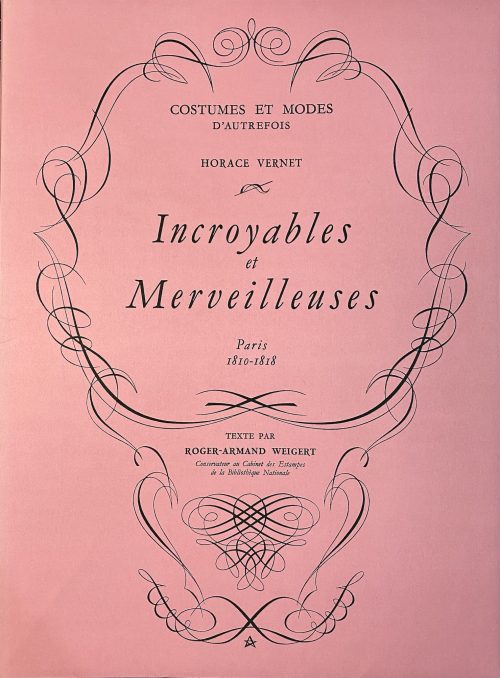 Title: COSTUMES ET MODES | D’AUTREFOIS | HORACE VERNET | Incroyables | et | Merveilleuses | Paris | 1810–1818 | TEXTE PAR | ROGER–ARMAND WEIGERT | Conservateur au Cabinet des Estampes | de la Bibliothèque Nationale | ÉDITIONS ROMBALDI | PARIS || Content: 24 photomechanical reproductions of the images from Bibliothèque nationale de France, printed on vélin paper from Papeteries Aussedat by Papeteries de la Moselle printing presses and stencil-coloured by Edmond Vairel. Text printed by Imprimerie Kapp on October 20, 1955. A print run of 4,000 copies, of which this is №122. Exterior: Pink lettered dust jacket over wrappers. Pagination: loose double leaves, [4 blanks] [4 h.t. and t.p.], i-xi [xii], 24 unnumbered plates, [4 blanks].
Title: COSTUMES ET MODES | D’AUTREFOIS | HORACE VERNET | Incroyables | et | Merveilleuses | Paris | 1810–1818 | TEXTE PAR | ROGER–ARMAND WEIGERT | Conservateur au Cabinet des Estampes | de la Bibliothèque Nationale | ÉDITIONS ROMBALDI | PARIS || Content: 24 photomechanical reproductions of the images from Bibliothèque nationale de France, printed on vélin paper from Papeteries Aussedat by Papeteries de la Moselle printing presses and stencil-coloured by Edmond Vairel. Text printed by Imprimerie Kapp on October 20, 1955. A print run of 4,000 copies, of which this is №122. Exterior: Pink lettered dust jacket over wrappers. Pagination: loose double leaves, [4 blanks] [4 h.t. and t.p.], i-xi [xii], 24 unnumbered plates, [4 blanks].Weigert, Roger-Armand (French, 1907-1986).
Émile Jean-Horace Vernet [Horace Vernet] (French, 1789 – 1863). Gatine, Georges Jacques (French, 1773 – after 1841). -
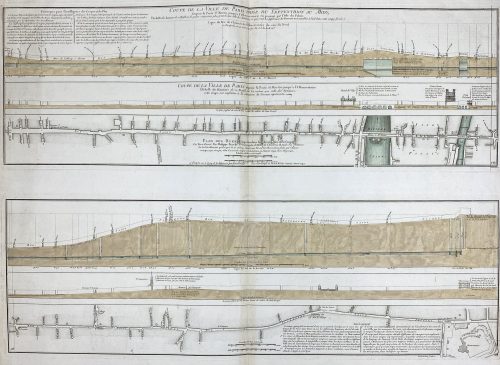
Two prints on one sheet of watermarked laid paper.
Coupe de la ville de Paris prise du septentrion au midy, depuis la porte St Martin jusqu'à l'Observatoire en passant par l'isle du Palais... Coupe de la ville de Paris depuis la porte St Martin jusqu'à l'Observatoire... Plan des rues comprises dans la direction dela coupe... / Le tout dressé par Philippe Buache... ; Desbruslins, sculpsit.
Watermark: "IHS" within circle; countermark of "FIN/ DUPUY/ AUVERGNE 1749".
LOC dates it to 1757. Gallica – to 1742, though the watermark is 1749.


